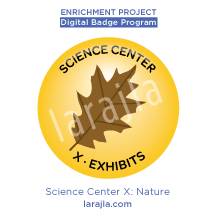 You can bring nature into your Science Center or take your activities outside. Let’s see how we can incorporate science in to our activities / exhibits.
You can bring nature into your Science Center or take your activities outside. Let’s see how we can incorporate science in to our activities / exhibits.
NOTE: Only general ideas are given for this theme. Be sure to explore ideas online or at your local library.
Steps
1. Schoolyard and community habitats.
A habitat can be considered a Science Center in and of itself. Not only are plants involved, but you can include everything from designing the habitat to studying and providing for the wildlife you attract. Research more about the possibility of creating your own habitat.
2. Community garden.
Growing your own food, starting and harvesting seeds, caring for the soil and more can all be included into your own Science Center. You can even go into reusing kitchen trash as compost, plants for your garden and more. Do you have an area you can use for a community garden that can double as a Science Center?
3. My backyard.
You have a Science Center available any time. Research your area to learn about the flora, fauna, animals, insects and more that are native to you. Find the issues that are faced, such as invasive species, and how you can help. Use the knowledge and support for your local species as the basis for your Science Center.
4. Seeds and plants.
The life of a plant from seed to plant to seed again can be shown by stages so the kids can see the seed become a plant over time. Some seeds take very little time to grow, so these might work best. In addition to looking at different stages, you can show how different types of environments affect the seeds. For an additional step, provide seeds so your visitors can grow a plant at home.
NOTE: If you don’t have access to an outdoor nature area, items such as rubbing sheets and container plants can help bring plants indoors.
5. Mini greenhouses.
When you think of growing plants, you think of seed starters and garden. Instead, you can use recycled clear bottles, balloons and more to house your plants. Herbs are a great choice for mini greenhouses. For variety, you might want to check out some air plants as well.
6. Mold.
Use leftover food to grow mold. Be sure your containers are clear, sealable and can be thrown away when you’re done. Not all types of mold are bad. Look at how you might incorporate mold in your center.
7. Worm watching.
Use layers of soil, sand and leaves in a small, clear container with a lid with air holes. Water the soil daily and watch the worms mix the soil and bring air down. What other ways might you find to show this happening?
NOTE: You may want to do ants instead of worms as they are always entertaining to watch.
8. Dinosaurs.
Exploring fossils, learning how to excavate and more can be incorporated with dinosaurs. This is a big draw . . . especially for boys. How can you use dinosaurs as a main focus in your center?
9. Department of Natural Resources.
The Enrichment Project has badges for four of the DNR’s programs:
- Project Flying WILD (birds)
- Project Learning Tree (plants)
- Project WET (fish)
- Project WILD (animals)
The experiments and activities are designed to be used by teachers with kids. By taking the class, you not only get to try out some of the activities and learn about adapting them, you receive the book. Check out the possibility of adding these activities into your Science Center.
10. Explore more!
Don’t stop! Nature is right out your door. Many of the other “Science Center X” badges can also be used for this badge program. Of course, you can also look for even more ideas to offer.
Supplements
SUPP_SCR_Biology.pdf
- Scramble: Biology
SUPP_SCR_Botany.pdf
- Scramble: Botany
SUPP_SCR_Ecology.pdf
- Scramble: Ecology
SUPP_WF_Biology.pdf
- Word Find: Biology
SUPP_WF_Botany.pdf
- Word Find: Botany
SUPP_WF_Ecology.pdf
- Word Find: Ecology
SUPP_Exhibit Planner.pdf
- Exhibit Planner — Pre-planning and testing questions
SUPP_Scientific Inquiry.pdf
- Scientific Inquiry — Printables for use with any exhibit theme
Sites to Explore
- www.fws.gov/cno/pdf/HabitatGuideColor.pdf
- www.nwf.org/How-to-Help/Garden-for-Wildlife/Schoolyard-Habitats.aspx
- schoolgardens.org/schoolyard-habitat-program-2
- www.naturalearning.org/kids-dig-dirt-green-paper
- www.kidactivities.net/post/School-Age-Science-Center-Supply-List.aspx
- www.exploratorium.edu/explore
- www.discoveryeducation.com/teachers/free-lesson-plans
- kids.usa.gov/teachers/lesson-plans/science/index.shtml
- www.teach-nology.com/teachers/lesson_plans/science
- www.sciencefairadventure.com
- www.yoursciencefairprojects.com
- www.sciencefair-projects.org
- www.sciencebuddies.org
- www.freesciencefairproject.com
- tryscience.org
- sciencenetlinks.com/lessons
- www.education.com/activity/science
- pbskids.org/zoom/activities/sci
- www.sciencebuddies.org
- howtosmile.org
- instructables.com
- www.msms.bayer.us/msms/MSMS_Home.aspx
- www.smithsonianeducation.org/educators/lesson_plans/science_technology.html
To download a PDF of this badge program, click here: EP_SCX_Nature
Leave a Reply